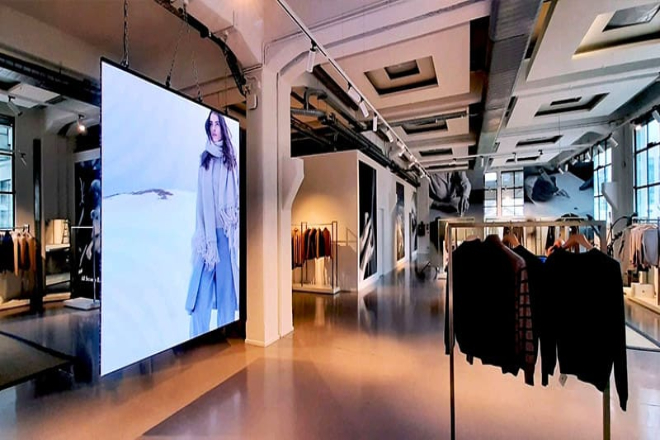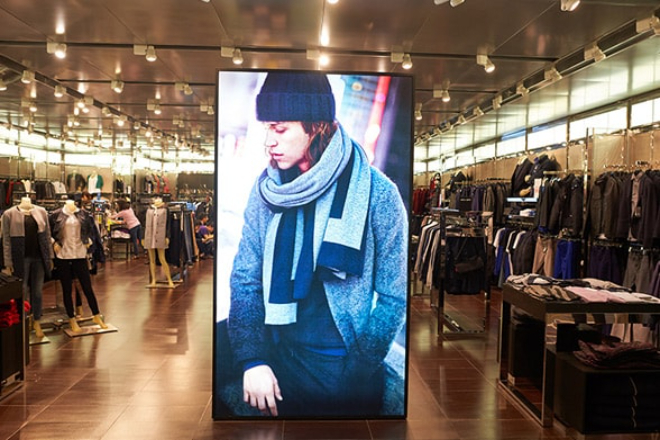序章

で ショッピングモール, squares, スタジアム, and other places, we often see colorful and clear LED displays, which play an important role in advertising and information display.
Many companies and individuals also want to buy LED displays, but in the process of understanding, they will find that the maintenance costs of some LED displays are relatively high, which confuses them.
So, why are the maintenance costs of some LED displays more expensive? Let’s discuss it together.
目次
Reason 1: The quality of the LED display itself
1). Differences in the core components of LED displays
The LED display is like a large machine composed of many small parts. The most important parts are LED lamp beads, drive circuits, power systems, and control systems.
The quality of these parts directly determines how long the display can be used and whether the picture is good, and also affects the subsequent maintenance costs.
Take LED lamp beads as an example; they are the “small light bulb” that emits light on the display. Good-quality lamp beads have high brightness and bright colors and are not easy to break。
Poor-quality lamp beads may appear dim, flicker, or not bright after a short time. Imagine if there are many such “bad bulbs” on the display screen; the picture will become ugly, and maintenance personnel will be needed to replace these lamp beads, which will incur additional costs.
The driving circuit is like the “commander” of the display screen, which is responsible for controlling the on and off of the lamp beads and the display effect.
If the driving circuit is of poor quality, the display screen may have problems such as screen flickering and stripe interference, and it is more troublesome to repair, and the cost is naturally high.
2). LED display cabinet structure and materials
The cabinet of the LED display screen is like its “shell”, which not only affects whether it is convenient to install, but also whether it can be waterproof, dustproof and heat dissipation.
Good quality cabinets are usually made of sturdy and durable materials, and the design is also reasonable. They can effectively protect the internal electronic components, reduce the probability of failure, and reduce maintenance costs.
On the contrary, some poor quality cabinets may be deformed and damaged in a short time, causing rain and dust to enter the interior and damage the electronic components. At this time, the entire display screen needs to be repaired, and the cost will increase significantly.
Reason 2: Challenges brought by the use environment of LED display screens

1). Outdoor environment:
1.1). High-temperature roasting:
When summer comes, the outdoors is like a natural oven. LED display screens are installed outdoors and have to endure high-temperature “roasting” every day.
Just imagine the sun is scorching, the surface temperature of the display screen can soar to 60 or 70 degrees, and the electronic components inside are being roasted on fire.
Over time, the solder joints begin to desolder, the capacitors swell like buns, and the chip performance degrades severely.
According to statistics from those who are engaged in technology, the failure rate of LED display screens in high-temperature environments is more than three times higher than that in normal-temperature environments.
Moreover, high temperatures will accelerate the aging of electronic components. The lamp beads that can be used for 100,000 hours may not work for 50,000 hours. In this way, the overall life of the display screen is greatly shortened.
In order to cope with high temperatures, an efficient heat dissipation system must be added to the display screen, such as aluminum heat dissipation fins, fans, and heat pipe heat dissipation technologies.
However, in this way, the manufacturing cost has increased, and the maintenance cost has also increased. The fan must be checked regularly to see if it is rotating, and the heat dissipation holes must be cleaned of dust frequently.
Otherwise, the heat dissipation effect will be poor, and the display screen will suffer again.
1.2). Heavy rain attack:
Heavy rain is a life-or-death test for outdoor LED display screens. If the waterproof level of the display screen is not enough, once the rain seeps in, the circuit will be short-circuited immediately, and all the electronic components will be burned.
Once, after a heavy rain, many outdoor display screens were scrapped, and the repair cost was as high as hundreds of thousands.
Moreover, the metal structure of the display screen is prone to rust and corrosion after being soaked in a humid environment for a long time, and the strength is reduced, and it may collapse one day.
After each heavy rain, the display screen must be fully inspected, and circuit testing, waterproof sealing treatment, and structural reinforcement are all necessary.
These maintenance tasks are time-consuming and laborious, and the cost is frighteningly high.
1.3). Dust attack:
There is a lot of dust outdoors, and those tiny dust particles are like small insects, drilling into the heat dissipation holes of the LED display screen.
Once the heat dissipation holes are blocked, the heat dissipation effect is greatly reduced, and once the temperature inside the display screen rises, the components age faster.
Moreover, if there is too much dust, it will also affect the display effect of the LED display screen, and the picture will look blurry.
In order to clean the dust, the display screen must be disassembled and cleaned regularly. This work is dirty and tiring, and it is easy to damage the display screen.
1.4). Strong light interference:
When strong light shines outdoors, the contrast of the LED display screen drops sharply, the picture becomes blurred, and the color is distorted. In order to make the display screen visible even under strong light, high-brightness LED lamp beads and advanced image processing technology must be used.
But in this way, the manufacturing cost has increased again. Moreover, under strong light, the audience’s eyes are easily fatigued after looking at the display screen for a long time, which affects the viewing experience.
Therefore, outdoor display screens must also have anti-glare and anti-reflection characteristics, and the technical threshold and cost have to be increased a lot.
2). Indoor environment:
2.1). Temperature and humidity fluctuations:
Although the indoor environment is relatively stable, there are sometimes some small problems. For example, if the air conditioner breaks down in summer, the indoor temperature rises all of a sudden, and the display screen also suffers.
When the temperature rises, the luminous efficiency of the LED lamp beads is reduced, the response speed of the drive circuit is also slowed down, and the picture begins to flicker and smear.
Also, during the rainy season in the south, the indoor humidity is particularly high, and condensation is easy to form inside the display screen. Once the circuit is short-circuited, the components will corrode.
In order to maintain a suitable temperature and humidity environment indoors, air conditioners and dehumidifiers must be installed, and the operating costs will rise immediately.
Moreover, these devices must be maintained regularly, and the energy consumption is not small.
2.2). Collision damage:
When there are many people indoors, the activities are frequent, and the display screen is prone to collision and extrusion. Sometimes, if you accidentally hit it, the lamp beads will fall off, and the bracket will be deformed.
Severe collisions can even cause the display screen to be scraped directly. Once the display screen is damaged, the maintenance cost is very high.
Especially for those high-resolution and large-size display screens, you have to find professionals to replace the lamp beads and repair the circuit, and the cost is frightening.
Moreover, these collisions are difficult to prevent. Even if guardrails are installed, and warning signs are set, they may still occur.
2.3). Static interference:
It is easy to generate static electricity when people walk indoors and when clothes rub against each other.
Once static electricity accumulates, it may discharge through the metal shell or circuit interface of the display screen, burning the internal electronic components.
In order to prevent electrostatic interference, the display screen must also have a good grounding system and electrostatic protection design.
However, this will increase the manufacturing cost and the difficulty of maintenance.
2.4). Electromagnetic interference:
There are many sources of electromagnetic interference in the indoor environment, such as radio equipment and power lines.
The electromagnetic radiation or electromagnetic induction they generate may affect the normal operation of the display screen, causing noise, stripes and other interference phenomena on the screen.
In order to resist electromagnetic interference, the display screen must use electronic components and circuit designs with strong anti-interference capabilities.
However, the introduction of these technologies has increased manufacturing costs and technical difficulties.
Reason 3: LED display screen maintenance operation is difficult
1). High professional maintenance requirements
The maintenance of LED display screens is not something that ordinary people can do. It requires professional technicians to operate, which requires maintenance personnel to have certain electronic knowledge and maintenance skills.
LED display screens integrate many sophisticated electronic components, such as lamp beads, driver chips, power modules, etc. Any problem with any component may cause the display screen to fail to work properly.
Once the display screen fails, it is difficult for ordinary people to repair it to their own ability, and they can only seek help from professional maintenance personnel.
The service fees of professional maintenance personnel are usually high because their professional skills and experience require a lot of time and effort to learn and accumulate.
Moreover, if the fault is serious, parts need to be replaced, and the price of parts is not cheap. The parts used in some high-end LED displays, such as customized driver chips, high-precision sensors, etc., are often very expensive.
In addition, some complex maintenance work may take a long time, and maintenance personnel need to conduct a comprehensive inspection and analysis of the display screen to find the root cause of the fault and repair it, which will also increase the maintenance cost.
2). Cumbersome maintenance procedures
The maintenance of LED display screens is not only about fault repair but also daily maintenance and inspection. Daily maintenance is essential to extend the service life of the display screen.
For example, it is necessary to regularly clean the dust on the surface of the display screen. Excessive dust accumulation will affect the heat dissipation effect of the display screen, causing the component temperature to be too high and damaged.
At the same time, it is also necessary to check whether the circuit connection is loose, because loose circuit connections may cause unstable signal transmission and affect the display effect of the display screen.
In addition, it is necessary to test various performance indicators of the display screen, such as 輝度, contrast, color reproduction, etc., to ensure that the display screen is always in good working condition.
Although these maintenance tasks seem simple, they require a lot of manpower and time. If there are a large number of display screens or the installation locations are scattered, the maintenance cost will be higher.
For example, in a large shopping mall, multiple LED display screens are installed in different locations. Maintenance personnel need to check and maintain them one by one, which not only takes a lot of time but also requires a lot of manpower.
Moreover, due to the scattered installation locations of the display screens, maintenance personnel may need to move the equipment frequently, which increases the difficulty and cost of the work.
Reason 4: Energy consumption increases costs

We all know that LED displays are “power hogs” when they are running.
For example, in some large shopping malls and stadiums, the huge LED advertising screens are set to a very high brightness so that the audience can see clearly from a long distance, but the price behind this is that the electricity bill is skyrocketing.
Take a medium-sized shopping mall as an example. The huge LED advertising screen inside is on from morning to night every day.
In a month, the electricity bill will cost several thousand yuan, which is not a small amount.
If the display screen is less energy efficient, the situation will be even worse. An inefficient display screen is like an inefficient person who wastes a lot of electricity.
When it converts electrical energy into light energy, a lot of energy is dissipated as heat energy, which means that to achieve the same brightness, it consumes much more electricity than a high-efficiency display screen.
Some old-fashioned LED displays have outdated technology and pitifully low energy efficiency. Compared with the new high-efficiency displays, the operating costs are simply a world apart.
Moreover, long-term high-energy consumption operation is like a nightmare for the electronic components inside the display.
Electronic components work under high temperatures and high loads for a long time, just like people who have been doing heavy work and working in a high-temperature environment, and they age very quickly.
For example, the brightness of the lamp beads inside will become lower and lower under high temperatures. It will become dim and dull after a short time. When the driver chip is running under high load, it is also easy to malfunction.
The performance is getting worse and worse, and failures come one after another. With the aging of electronic components, the probability of display failure is greatly increased.
Once the display is broken, you have to find someone to repair it or replace parts, which is another additional expense.
Moreover, the display is always broken, which affects normal use and brings a lot of trouble and losses to merchants or users.
Reason 5: Differences in LED display brands and after-sales service
1). Brand affects quality and cost
In the LED display market, the gap between different brands is really different, especially in terms of quality and price. Like some well-known big brands, they have been struggling in the market for many years, with strong R&D strength and a strict quality control system.
In order to create high-quality display screens, these brands do not hesitate to use top-level materials, such as high brightness, low-attenuation lamp beads, extremely stable driver chips, and sturdy and durable shells.
At the same time, using advanced production technology, every production link is refined to ensure that the product quality is foolproof. However, such high quality also means high cost, so their display screens are relatively expensive.
On the contrary, some small brands or miscellaneous brands of display screens, in order to fight a “price war” on price and attract consumers, often use materials of average quality and relatively rough production processes.
Although the price looks attractive, the quality is worrying. These display screens may be fine for a short time, but over time, various faults will follow.
For example, the lamp beads are easy to break, and the screen has problems such as flowery screens and flickering. It is very troublesome to maintain them in the later stage, and the maintenance cost will also increase significantly.
2). Imperfect after-sales service
When buying an LED display, after-sales service is like a “reassurance pill” that allows consumers to have no worries. However, the reality is that the after-sales service of many brands is not perfect.
Some brands talk a lot when selling and promise to provide high-quality after-sales service, but once there is a problem with the display, when consumers contact after-sales, either the phone is not connected, or the after-sales staff has a bad attitude, and the repair time is delayed again and again, seriously affecting the normal use of the display.
What’s more hateful is that some unscrupulous merchants set up various traps in after-sales service in order to make huge profits.
For example, deliberately exaggerating the severity of the fault during maintenance and charging high maintenance fees or using inferior parts for replacement, resulting in continuous subsequent problems with the display.
These behaviors not only increase consumers’ maintenance costs but also make consumers lose trust in the LED display market.
Reason 6: Customized needs and software problems

1). High customization cost
In the use scenarios of LED displays, many users have their own “little thoughts” and have special requirements for the display.
For example, those who run creative exhibition halls may request customized display screens of specific sizes to make the display effects cool and unique.
For example, they want ultra-narrow bezels and special-shaped splicing styles to perfectly match the spatial layout and design style of the exhibition hall, or they want the display screen to have special functions, such as touch interaction and real-time data visualization.
Compared with standard products, customized products are very different. Just like a privately tailored suit and ready-made clothes sold in shopping malls, customized products must be designed and produced separately by manufacturers according to the specific needs of users.
This requires a lot of manpower, material resources, and time. Starting from the design drawings, you have to think about and modify them repeatedly, and you have to pick and choose when selecting parts.
During the production process, you have to constantly adjust the process, just in case there is a problem with any link. Therefore, customized products are naturally much more expensive than standard products.
Moreover, the parts of customized products are very “personalized,” and it is difficult to find direct replacements on the market.
If the display screen is broken and parts need to be replaced, the manufacturer may have to re-open the mold for production or purchase from a specific supplier. In this way, the cost of replacing parts is high.
If the supply of parts cannot keep up, the display screen will have to “strike” for a long time, causing great trouble to users.
2). Poor software compatibility
Some LED display screens rely on specific software to operate and manage content. This software is not free.
Some have to be purchased, and there are various restrictions on the use of the license. For example, it can only be installed on specific devices and the use period is limited.
What’s more annoying is that the software update is too untimely. Now technology is developing rapidly, and the functions and performance of LED display screens are constantly upgrading, but the supporting software can’t keep up with the pace.
This leads to a lot of problems when users use it, such as not supporting new display formats and not connecting smoothly with other devices.
If the software is incompatible with the user’s existing information system, it will be a mess. The user may have to make a big fuss about the existing information system, remodel it, or develop additional interfaces so that the software and system can be connected.
This costs a lot of money, and professional technicians have to be found to develop and debug. During the transformation and development, various unexpected problems may arise, which will delay the project delivery time and affect the normal use of users.
7. 結論
Through the above analysis, we can see that the high maintenance cost of LED display screens is caused by a variety of factors.
When purchasing LED display screens, we cannot only look at the price but also comprehensively consider factors such as the quality of the display screen, the use environment, technical parameters, and after-sales service.
At the same time, during use, we must also pay attention to daily maintenance and care to extend the service life of the display screen.
最後に、LEDディスプレイスクリーンについてさらに詳しく知りたい場合は、 ご連絡ください。
